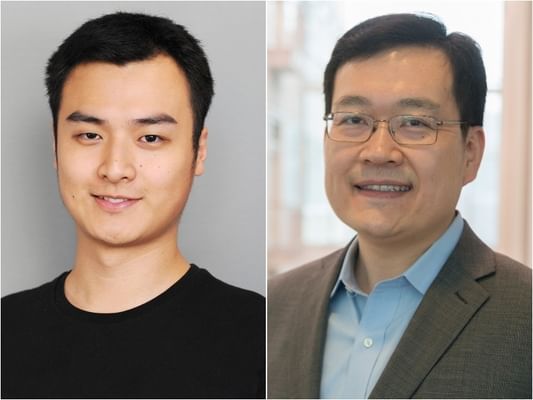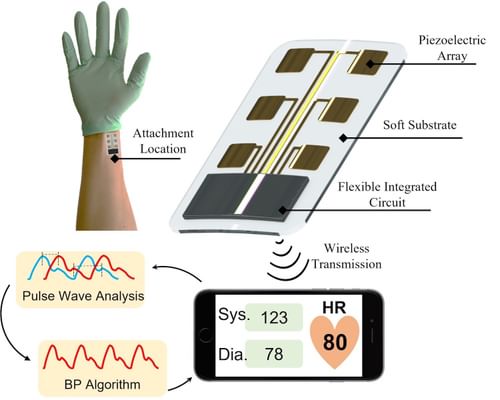- Undergraduate
Bachelor's Degrees
Bachelor of ArtsBachelor of EngineeringDual-Degree ProgramUndergraduate AdmissionsUndergraduate Experience
- Graduate
Graduate Experience
- Research
- Entrepreneurship
- Community
- About
-
Search
All Thayer News


Dartmouth Engineering Study Makes Journal's List of Most Cited Articles
Mar 23, 2023 | by Catha Mayor
Dartmouth Engineering PhD candidate Congran ("Billy") Jin is first author on a paper that recently made the list of most cited articles published since 2020 in Sensors and Actuators A: Physical. The paper, "Flexible piezoelectric nanogenerators using metal-doped ZnO-PVDF films," was published in April, 2020, and has been cited over 70 times. The co-authors were Thayer students, faculty, and research associates, including many working with Jin in Professor John Zhang's lab.

l to r: PhD candidate and first author Congran Jin, and Professor John X.J. Zhang. (Additional co-authors: Nanjing Hao, Zhe Xu, Ian Trase, Yuan Nie, Lin Dong, Andrew Closson, and Zi Chen.)
We spoke with Jin about the cited study and what's next for him and this research:
Why has your paper generated so many citations?
The major innovation presented is the design of a flexible wearable device, like a patch, that can be used as both an energy harvester and a motion sensor. As an energy harvester, it converts biomechanical energy from human body motion into electricity to charge small electronics. As a motion sensor, you can wear it, for example, on your wrist, and you can see the electrical signal coming from the sensor making different voltage waveforms or patterns. Based on the different patterns, you can determine what kind of motion you're doing.
What's special about your device?
We were able to improve both the motion sensitivity and the voltage generation of the device by doping the zinc oxide nanostructure with different metals. We started with zinc oxide and a flexible polymer called PVDF [polyvinylidene fluoride]. Both are piezoelectric on their own, meaning they can convert mechanical energy to electrical energy. But then we doped the zinc oxide with a series of metals including cobalt, sodium, silver, and lithium, and discovered that lithium creates the largest energy output. So you end up with a flexible thin film that's comfortable to wear and optimized for both motion tracking and power generation.
How could this help people?
People have a lot of small electronics—cell phones, smart watches, and other wearable electronics—and they all need power. And people move around a lot. So imagine if we could capture that energy to power small electronics. We would save energy, help the environment, and reduce the need for batteries.

PulseFlex wearable blood pressure monitor. (Image courtesy Congran "Billy" Jin)
As for sensors, my co-author and lab-mate Andrew Closson, and my PhD advisor Professor Zhang, and I co-founded a startup called PulseFlex, and we use a similar mechanism to continuously monitor heart health through the detection of artery pulse. A lot of smartwatches can measure heart rate, but we use the piezoelectrical material to sense the pulse wave in order to monitor blood pressure. This is something new. Blood pressure cuffs take a long time to measure just one data point and aren't always accurate. There's evidence that you can extract blood pressure information from the pulse wave. So we're working on that. Because imagine if there's a tiny device you can wear and measure your blood pressure anytime, anywhere, continuously. That's a lot of useful data for people to better manage their health.
What's next for this research?
This work is sponsored by an NIH-funded project at Dartmouth about designing and developing implantable energy harvesters that are encapsulated within a biocompatible material. These could then be incorporated to power medical implants, such as pacemakers, to make the device last longer and avoid the risk of extra surgeries.
What's next for you?
I'm graduating from the PhD program this Spring and looking to continue innovating biomedical technologies that could improve and advance medical devices. Previously, I was a pure mechanical engineer because I did my ME undergrad and master's at RPI. Then I ended up here in Professor Zhang's lab, and he has a great biomedical engineering atmosphere. I participated in a lot of projects and learned a lot of new techniques, like nanomaterials synthesis, device design, and plasmonic sensing. I think the healthcare industry will always exist and keep growing because of technology progression, and it's an industry where you can actually help people and improve their wellbeing.
For contacts and other media information visit our Media Resources page.
